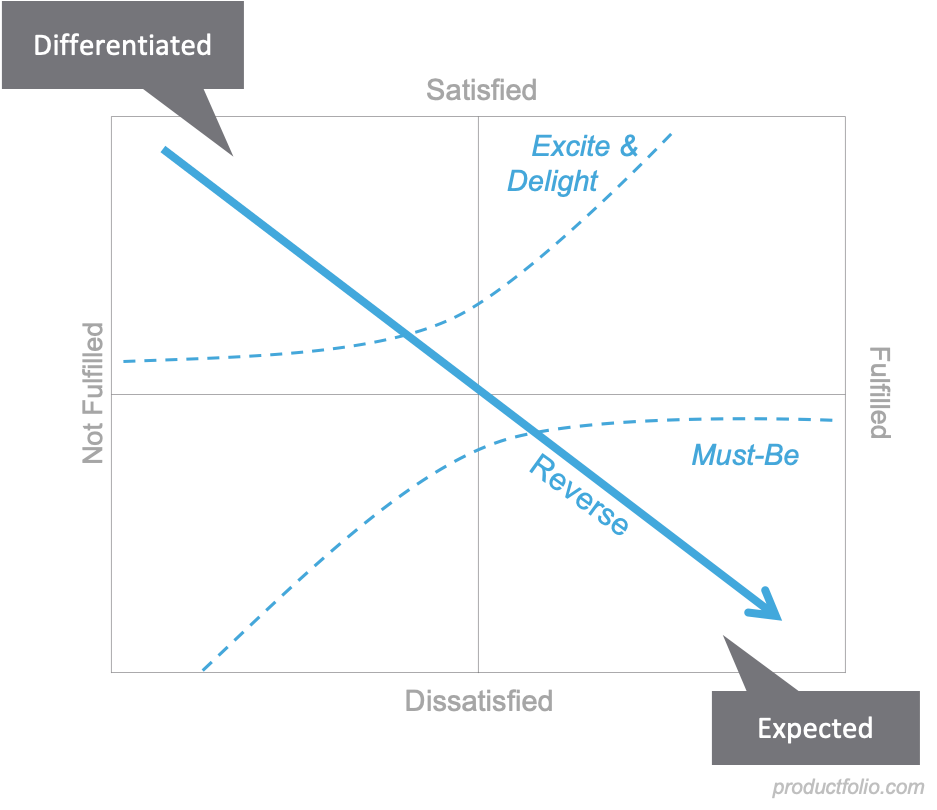The Kano Model is a simple four-point chart that is often used in Product development to help determine user satisfaction. The Model was created by Noriaki Kano and his team in 1984 to help categorize and prioritize their customers’ needs, guide product development and enhance their users’ satisfaction. This model challenges the conventional idea that improving every aspect of your product and/or service leads to increased customer satisfaction. The Kano model gets more specific and helps a Product Manager to determine which aspects of a product will simply maintain satisfaction if it’s improved and which aspects of the product will increase customer delight if it’s improved. Being able to pinpoint the specific areas of a product that will generate the most customer delight helps to avoid expending time and resources unnecessarily.

Categories of The Kano Model
The Kano model has two Axis’, an X-axis, and a Y-axis. On the X-axis you have whether a need was met poorly and on the other side of the axis, was the need met very well. The Y-axis shows how the customer responded. On one end of the axis, you have delighted, and on the other end you have dissatisfied. Let’s look at each of the users’ needs in detail.
Delighted – Delighted is the best response to a users’ experience
Dissatisfied – Dissatisfied is the least desirable response from a user experience
Note: It’s important to note that the response can be in varying places on this scale ranging from Delighted as the best response, to satisfied being just under delighted Neutral falls in the middle, and dissatisfied is the worst response.
Not Delivered – Represents the lack of implementation of a product that may also reflect the lack of investment that was put into the product.
Fully Delivered – Fully Delivered is a measurement of the implementation and investment into the Product.
The Three Basic Needs:
Beyond the X and Y-axis of the Kano model, you will have user needs that are to be broken down into three categories:
- Must Be Quality – Must be quality refers to expectations that customers have when using your product. It also refers to the basic necessities that a product needs in order to function. Example: A customer might expect a laptop to have USB port. If the laptop does not have a USB port the customer will need to buy an adapter in which case the overall satisfaction with the product is decreased.
- One-Dimensional Quality – This is a performance attribute in which more is better. Better performance or more features create a higher satisfaction rating. Example: A customer buys a laptop expecting the battery life to be 12 hours. To their surprise, the battery life on this new model is doubled and is now 24 hours. This is a great improvement on an existing expectation that has now increased the customers’ satisfaction.
- Attractive Quality – This is the Excitement attribute. In this scenario, you are offering your customers something that was not unexpected and is unforeseen. The goal here is to give them something they did not know they wanted so that they will want it again in the future. It’s the opportunity to introduce a new need or desire for the customer. Example: A customer buys a new laptop, and their whole life they have used the trackpad that is built into the laptop. To their surprise, the new laptop comes with a wireless mouse at no extra charge. At this time wireless mouses are new to KANO the market and it creates a WOW factor, which increases customer satisfaction, and introduces them to a new product.
Reversal
While you’re in the development phase of your product, you’ll be determining which features are “must-haves” and which features are “delighters”. The key to a good product is to find a balance between the two. Keep in mind during this process that there is a time dimension that occurs where your “delighters” eventually become “must-haves”. A feature that originally created a “wow” response overtime becomes an expectation, this is called reversal. The goal with this framework is to plot your must-haves vs. your differentiating delighters and then strike the right balance.
Using the Kano Model
The Kano Model is a great tool for determining customer needs as well as measuring customer satisfaction. It offers insights into product attributes that your customers expect as well as features that will create delight. It’s a great tool for Product Managers to use with their teams to encourage discussion and support while developing new features in a product.